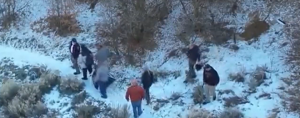In a perplexing turn of events, a 17-year-old foreign exchange student from China, reported missing in Utah last week, was discovered in what authorities describe as an apparent “cyber kidnapping” scheme aimed at extorting $80,000 from the student’s family.

The ordeal began when the student was reported missing on Friday, just a day after he was last seen at the Riverdale residence where he had been staying, located approximately 30 miles from Salt Lake City. Initially, Riverdale police suspected a forcible abduction from his home. However, a twist emerged on Sunday night when authorities revealed that the student was found safe, albeit in an unexpected location — inside a tent approximately 25 miles away from Riverdale in the Brigham City area.
The circumstances surrounding the student’s isolation took a peculiar turn, with police indicating that he believed his family in China was under threat, compelling him to seclude himself. The details regarding how he acquired this information and the reasons behind his self-isolation remain unclear.
Simultaneously, the student’s family received a ransom note along with a photograph depicting the student in a manner suggesting he had been abducted and was in imminent danger. Distressed by the apparent threat to their loved one, the family opted to pay the demanded ransom of $80,000. It was only after the ransom was paid that the authorities located the student in the tent.
The case underscores the disturbing intersection of technology and crime, with the term “cyber kidnapping” coming to the forefront. While traditional kidnappings involve physical abductions, this incident points to a virtual dimension where threats, coercion, and ransom demands are executed through digital means.
The motive behind targeting the exchange student and the mechanism through which the cyber-kidnappers orchestrated the scheme remain under investigation. Authorities are likely to delve into the complexities of online communication, financial transactions, and the traceability of digital threats to unravel the full scope of this unconventional case.
As the student is reunited with his family, questions linger about the psychological toll of the experience and the potential lasting impact on his well-being. Additionally, this incident serves as a stark reminder of the evolving nature of criminal activities, necessitating ongoing vigilance and adaptation of law enforcement strategies to combat emerging threats in the digital age.
Read Also – OAS Secrets: The Greatest Methods for Increasing OAS to the Maximum

